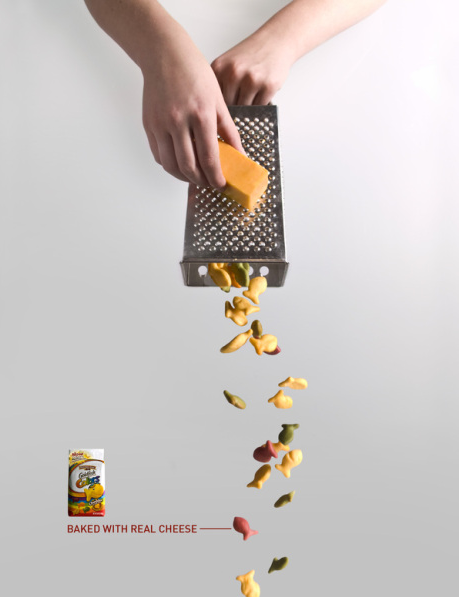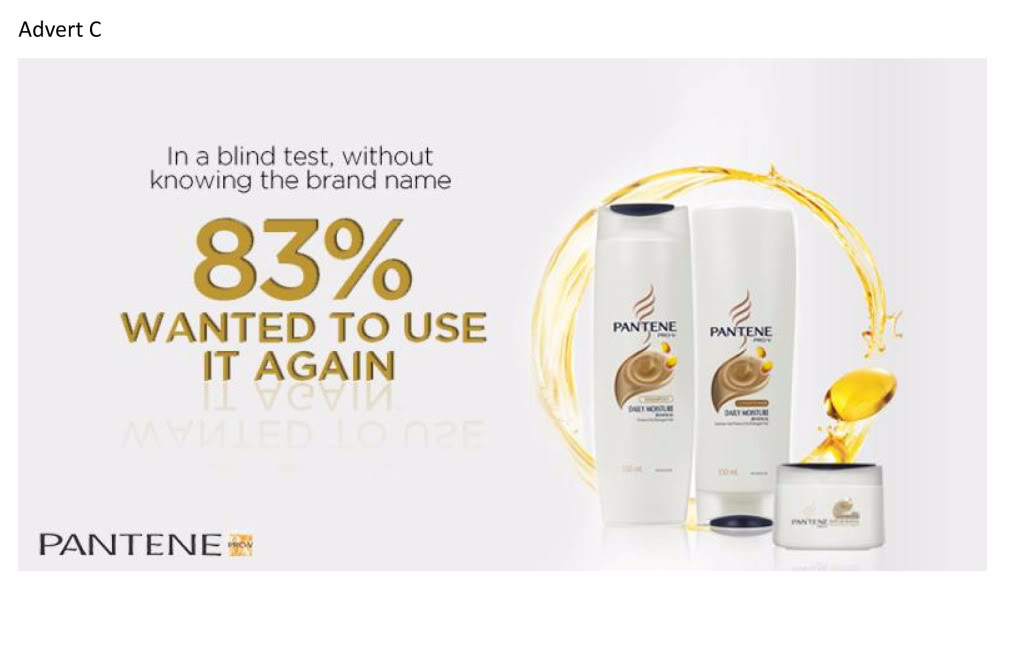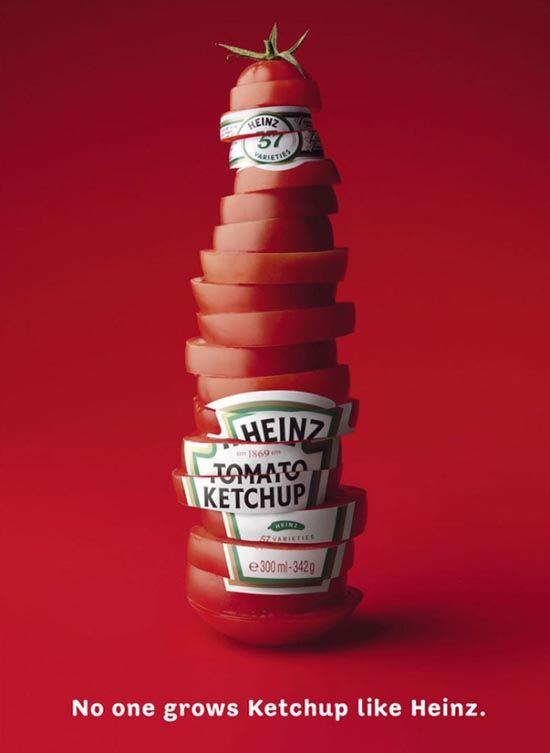Informative Advertisement

Figure 1 shows the advertisement of Goldfish crackers (Goldfish Magazine Advertisement, 2011). The advertisement uses a simple image of the ingredient used to make the product. The advertisement aims to inform the readers that the brand (Pepperidge Farm) uses cheese, and no artificial flavor, to make the product. The advertisement presents the image of a hand shredding cheese that is turning into the goldfish snacks. This image indicates two things – first, what the product is made of and second, the quality of the product. The emphasis on the quality of the product is clear from the tagline of the advertisement, “Baked with real cheese” (Goldfish Magazine Advertisement, 2011).
The target customers for the product are the people who are conscious about the quality of the product. By emphasizing on the quality and purity of the ingredient, the brand intends to pull customers to buy the product. The image in the print advertisement tries to emphasize the quality of the product. Therefore, the target customers for the product are the parent of children who are the main consumers of the product. The brand tries to influence the parents by assuring them of the product quality.
The advertisement is interesting as it immediately catches the attention of the readers. The image of the hand shredding cheese that is turning into goldfish crackers immediately catches the attention of the readers. The image instantly ignites the interest of the readers, as the customers understand that goldfish crackers are made of real cheese. The advertisement is supposed to excite the desire to purchase the product. However, the advertisement does not suggest the action that a customer should take after seeing this advertisement. Thus, the advertisement gives information but does not push the customer to purchase the product.
The Goldfish advertisement is an appeal to the customers to buy the product. Therefore, the advertisement appeals to the rational customer who wants to be sure about the quality of the product.
This advertisement is a good example of an informative advertisement as it gives the customers the information that the product is made of real cheese and not by additive flavor. The advertisement presents the information efficiently. However, the brand name is almost illegible as only the image of the product is given on the left-hand side. It does not contain a separate image of the brand name and/or logo.
Persuasive Advertisement

Figure 2 shows an example of a persuasive advertisement (Photobucket, 2017). The advertisement is that of Pantene shampoo. The advertisement shows the picture of a Pantene shampoo, conditioner, and mask. Also, the advertisement has the result of a blind test written on the left-hand side of the advertisement, “In a blind test, without knowing the brand name – 83% wanted to use it again” (Photobucket, 2017). The object of the advertisement is to persuade the target customers to use the product that research has proven to be preferred by the participants (Kotler & Armstrong, 2013). The test result is used as a tool to differentiate the product from its competitors and therefore, appeal to the viewer’s rationality to purchase it.
The target customers are beauty conscious women who look for a product that would give them good results. The age group of targeted customers is 18 to 40. Therefore, the use of the test result was a good persuasion tool that would create an image of a better product to the target customers.
The advertisement does not catch the attention of the readers. The advertisement is plain and simple. It only shows the image of the products with no other interesting image. The only thing that catches the reader’s eyes is the words that are shown on the left side of the advertisement. The words are written in bold and large fonts regarding the blind test. This information presented in the advertisement is expected to stimulate interest among the readers as it is expected to catch their attention. The minimalistic advertisement directs the attention of the readers to the words and not to the image. The advertisement is supposed to excite a desire among the target customers to buy the products because of the result of the blind test. The advertisement shows no action.
The message makes a rational appeal to its users. The reference to the blind test shows that the brand considers its users rational and want them to judge the product by its performance and not by celebrity-endorsement. The advertisement aims to attract the customer, thereby, adopting a pull strategy.
The advertisement is static with little movement and it does not catch the reader’s attention. The advertisement is unimpressive and dull. Though the advertisement is persuasive, as it delivers the content to the reader’s mind, it fails to attract the attention of the readers.
Reminder Advertisement

The aim of the advertisement by Heinz (see figure 3) is to deliver a short message to its target customers – Heinz makes ketchup from tomatoes and not artificial additives (McCann Erickson, 2011). The advertisement reinforces the product quality of the ketchup to its target customers and shows the ingredient used to make the product. The slice of tomatoes, stacked perfectly to form the ketchup bottle, is a classic signifier of the ingredient used in the product. This image is supposed to trigger a recollection, in the mind of the existing customers, of purity of Heinz ketchup.
The advertisement was placed in House and Home magazines. Heinz aims to retain existing as well as attract new customers. The target customers, therefore, are women who purchase household products. The majority of the readers of home magazines are women. Here, the main target customers of Heinz are women with children.
The advertisement attracts the attention of the reader, as the image is very intriguing. Slices of tomato neatly stacked one above the other to form a Heinz tomato ketchup bottle, immediately reminds the readers of the thickness and pure flavor of the product. The picture is very attractive and reminds the customers of the quality of Heinz ketchup. Thus, the image and the tagline interest the readers who feel that the advertisement shows them why Heinz is different from the other ketchup brands. The advertisement helps to infuse the desire to purchase the product as it appeals to the existing quality-conscious customers. It does not indicate any action that the customers should take after viewing the advertisement.
The advertisement appeals to the rationality of the viewer. The picture of the sliced tomatoes used to make the bottle of Heinz ketchup clearly shows the purity of the product and the tagline differentiates it from its competitors. Thus, Heinz aims to pull new as well as existing customers.
The advertisement is a good reminder advertisement as it shows the existing customers the product quality that is associated with the brand. The remainder is for repeat customers. This advertisement is expected to attract them for a repeat purchase. Further, it is also a good advertisement to attract new customers.
References
Goldfish Magazine Advertisement. (2011). Behance. Web.
Kotler, P., & Armstrong, G. (2013). Marketing. NSW, Australia: Pearson.
McCann Erickson. (2011). Heinz Ketchup. Web.
Photobucket. (2017). Photobucket. Web.